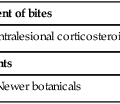Mucous membrane pemphigoid

First-line therapies
Treatment-resistant or severe disease
Second-line therapies
Third-line therapies
Mucous membrane pemphigoid in a series of 7 children and a review of the literature with particular reference to prognostic features and treatment.
Veysey EC, McHenry P, Powell J, et al. Eur J Pediatr Dermatol 2007; 17: 218–26.
The biologics, particularly the anti-TNF agent etanercept, may have a role, but evidence is limited.
Pentoxifylline (anti-tumor necrosis facter drug): effective adjunctive therapy in the control of ocular cicatricial pemphigoid.
El Darouti MA, Fakhry Khattab MA, Hegazy RA, Hafez DA, Gawdat HI. Eur J Ophthalmol 2011; 21: 529–37.
Adjuvant pentoxifylline appears beneficial in control of ocular disease; further evidence is needed.






 Topical corticosteroids
Topical corticosteroids Dapsone
Dapsone Anti-inflammatory antibiotics
Anti-inflammatory antibiotics Systemic corticosteroids
Systemic corticosteroids Cyclophosphamide
Cyclophosphamide Topical mitomycin
Topical mitomycin Mycophenolate mofetil
Mycophenolate mofetil Azathioprine
Azathioprine Methotrexate
Methotrexate Cyclosporine
Cyclosporine Intravenous immunoglobulin
Intravenous immunoglobulin Plasmapheresis
Plasmapheresis Rituximab
Rituximab Etanercept
Etanercept Infliximab
Infliximab Pentoxifylline
Pentoxifylline Topical tacrolimus
Topical tacrolimus Colchine
Colchine Low level laser
Low level laser
